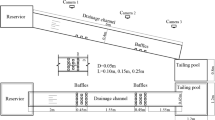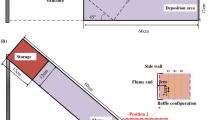Abstract
Debris flow can cause serious damages to roads, bridges, buildings and other infrastructures. Arranging several rows of deceleration baffles in the flow path can reduce the flow velocity and ensure better protection of life and property. In debris flow prevention projects, deceleration baffles can effectively reduce the erosion of the debris flow and prolong the running time of the drainage channel. This study investigated the degree to which a 6 m long flume and three rows of deceleration baffles reduce the debris flow velocity and affect the energy dissipation characteristics. The influential variables include channel slope, debris flow density, and spacing between baffle rows. The experimental results demonstrated that the typical flow pattern was a sudden increase in flow depth and vertical proliferation when debris flow flows through the baffles. Strong turbulence between debris flow and baffles can contribute to energy dissipation and decrease the kinematic velocity considerably. The results showed that the reduction ratio of velocity increased with the increase in debris flow density, channel slope and spacing between rows. Tests phenomena also indicated that debris flow density has significant influence on the mobility and deposition characteristic of debris flow. The deposit amount first increased then decreased when the flow density rises, and the deposit amount of debris flow density of 1500 kg/m3 reached the maximum when the experimental flume slope is 12°.
Similar content being viewed by others
References
Chen HK, Tang HM, Wu SF (2004) Research on abrasion of debris flow to high-speed drainage structure. Applied Mathematics and Mechanics 25: 1150–1156. https://doi.org/10.1007/BF02438281
Chen J, Chen X, Li Y, et al. (2015) An experimental study of dilute debris flow characteristics in a drainage channel with an energy dissipation structure. Engineering Geology 193: 224–230. https://doi.org/10.1016/j.enggeo.2015.05.004
Chen XQ, Cui P, Tang BX, et al. (2006) Civil engineering techniques for debris flow control in national parks. Chinese Journal of Geological Hazard and Control 17: 79–84. (In Chinese) https://doi.org/10.16031/j.cnki.issn.1003-8035.2006.02.018
Chen XQ, Wei FQ, Chen JG (2014) Step-pool structure debris flow guide groove and applicable thereof. China Patent: 201410001807 applied on 2014-4-2. (In Chinese)
Chen XQ, You Y, Cui P, et al. (2013) New control methods for large debris flows in Wenchuan earthquake area. Journal of Sichuan University (Engineering Science Edition) 45: 14–22. https://doi.org/10.15961/j.jsuese.2013.01.004 (In Chinese).
Choi CE, Ng CWW, Law RPH, et al. (2015) Computational investigation of baffle configuration on impedance of channelized debris flow. Canadian Geotechnical Journal 52: 182–197. https://doi.org/10.1139/cgj-2013-0157
Choi CE, Ng CWW, Song D, et al. (2014) Flume investigation of landslide debris–resisting baffles. Canadian Geotechnical Journal 51: 540–553. https://doi.org/10.1139/cgj-2013-0115
Cui P, Guo CX, Zhou J, et al. (2014). The mechanisms behind shallow failures in slopes comprised of landslide deposits. Engineering Geology 180(S1): 34–44. https://doi.org/10.1016/j.enggeo.2014.04.009
Cui P, Zeng C & Lei, Y. (2015). Experimental analysis on the impact force of viscous debris flow. Earth Surface Processes & Landforms 40(12), 1644–1655. https://doi.org/10.1002/esp.3744
Cui, P, Chen XQ, et al. (2011). The Wenchuan Earthquake (May 12, 2008), Sichuan Province, China, and resulting geohazards. Natural Hazards 56(1): 19–36. https://doi.org/10.1007/s11069-009-9392-1
European Commission (2009) The design of avalanche protection dams. In: Jóhannesson T, Gauer P, Issler P, et al. (eds.), Project Report EUR 23339. Climate Change and Natural Hazards Research, Series 2.
Gao Q, Chen XQ, Zhao WY (2010) A review: design of debris flow drainage canal. Chinese Journal of Geological Hazard and Control 21: 1–7. (In Chinese) https://doi.org/10.16031/j.cnki.issn.1003-8035.2010.02.026
Hákonardóttir KM, Hogg AJ, Batey J, et al. (2003) Flying avalanches. Geophysical Research Letters 30: 3–6.
Hong Y, Wang JP, Li DQ, et al. (2015) Statistical and probabilistic analyses of impact pressure and discharge of debris flow from 139 events during 1961 and 2000 at Jiangjia ravine, China. Engineering Geology 187: 122–134. https://doi.org/10.1016/j.enggeo.2014.12.011
Jia ST, Cui P, Chen XQ, et al. (2011) Experimental study of regulating barrage and transportion properties of debris flow by silt-trap dam. Chinese Journal of Rock Mechanics and Engineering 30: 2338–2345. (In Chinese).
Johnson AM, Rahn PH (1970) Mobilization of debris flows. Zeitschrift fur Geomorphologie 9 (Sup): 168–186.
Li DJ (1997a) Debris Flow Mitigation Theory and Practices. Beijing: Science Press. pp 132–148. (In Chinese).
Li DJ (1997b) The application of permeable dam in debris flow control. Chinese Journal of Geological Hazard and Control 8: 60–66. (In Chinese)
Li Y, Liu JJ, Hu KH, et al. (2012) Probability distribution of measured debris-flow velocity in Jiangjia Gully, Yunnan Province, China. Natural Hazards 60: 689–701. https://doi.org/10.1007/s11069-011-0033-0
Li Y, Liu J, Su F, et al. (2015) Relationship between grain composition and debris flow characteristics: a case study of the Jiangjia gully in China. Landslides 12: 19–28. https://doi.org/10.1007/s10346-014-0475-z
Mainali A, Rajaratnam N (1994) Experimental study of debris flows. Journal of Hydraulic Engineering 120: 104–123. https://doi.org/10.1061/(ASCE)0733-9429(1994)120:1(104)
Ng CWW, Choi CE, Kwan JSH, et al. (2014) Effects of baffle transverse blockage on landslide debris impedance. Procedia Earth and Planetary Science 9: 3–13. https://doi.org/10.1016/j.proeps.2014.06.012
Ng CWW, Choi CE, Song D, et al. (2015) Physical modeling of baffles influence on landslide debris mobility. Landslides 12: 1–18. https://doi.org/10.1007/s10346-014-0476-y
O’Brien JS and Julien PY (1988) Laboratory analysis of mudflow properties. Journal of Hydraulic Engineering 114: 877–887. https://doi.org/10.1061/(ASCE)0733-9429(1988)114:8(877)
Peterka AJ (1984) Hydraulic Design of Stilling Basins and Energy Dissipaters. United States Department of the Interior, United States Bureau of Reclamation, Report No. 25. Denver, CO, USA.
Tang C, Zhu J, Li WL, et al. (2009) Rainfall-triggered debris flows following the Wenchuan earthquake. Bulletin of Engineering Geology and the Environment 68: 187–194. https://doi.org/10.1007/s10064-009-0201-6
VanDine DF (1996). Debris Flow Control Structures for Forest Engineering. Britis Columbia Ministry of Forests Research Program, Working Paper 22/1996. Victoria, BC, Canada. pp 20–22.
Wang F, Chen XQ, Chen JG, et al. (2017) Experimental investigation of debris flow energy dissipation structure with different shapes of deceleration baffles. Engineering Geology 220:43–51. https://doi.org/10.1016/j.enggeo.2017.01.014
Wang ZY, Qi L and Wang X (2012) A prototype experiment of debris flow control with energy dissipation structures. Natural Hazards. 60: 971–989. https://doi.org/10.1007/s11069-011-9878-5
Wendeler C, McArdell B, Volkwein A, et al. (2008) Debris flow mitigation with flexible ring net barriers—field tests and case studies. WIT Transactions on Engineering Science 60: 23–31.
You Y, Liu JF, Ou GQ (2006) Comparison of hydraulic conditions among usual debris flow drainage canal. Chinese Journal of Rock Mechanics & Engineering 25: 2820–2825. (In Chinese).
Zeng QL, Yue ZQ, Yang ZF, et al. (2005) Functions of check dam against debris flow: comparison of two watersheds of Jiangjia gully, Yunnan, China. Chinese Journal of Rock Mechanics and Engineering 24: 3137–3145. (In Chinese).
Acknowledgements
This study was supported by the National Key Technology Research and Development Program of China (No. 2014BAL05B01), the Science and Technology Service Network Initiative of Chinese Academy of Sciences (No. KFJ-EW-STS-094), the National Science Foundation of China (No. 41302283), and the West Light Foundation of Chinese Academy of Sciences. Furthermore, we would like to thank the editors and two anonymous reviewers for their useful comments and suggestions.
Author information
Authors and Affiliations
Corresponding author
Rights and permissions
About this article
Cite this article
Wang, F., Chen, Xq. & Chen, Jg. Experimental study on the energy dissipation characteristics of debris flow deceleration baffles. J. Mt. Sci. 14, 1951–1960 (2017). https://doi.org/10.1007/s11629-016-3868-8
Received:
Revised:
Accepted:
Published:
Issue Date:
DOI: https://doi.org/10.1007/s11629-016-3868-8




